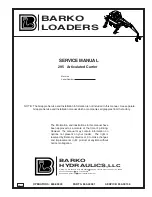
5.8.2 - Réglage excitation maxi (plafond d'excitation)
- réglage statique de la limitation de courant, potentiomè-
tre P5 (réglage usine : 10 A, calibre des fusibles : 10A - 10
secondes)
Le réglage usine correspond à celui du courant d'excita-
tion nécessaire pour obtenir un courant de court-circuit
triphasé d'environ 3 IN à 50 Hz pour la puissance indus-
trielle, sauf spécification autre.(*)
Pour reduire cette valeur ou pour adapter le Icc à la puis-
sance réelle maxi d'utilisation (machine déclassée) on
peut procéder à un réglage statique à l'arrêt, non dange-
reux pour l'alternateur et l'installation. Débrancher les fils
d'alimentation X1,X2 et Z1,Z2 la référence tension (0-
110V-220V-380V) de l'alternateur.
Brancher l'alimentation réseau (200-240V) comme indi-
qué (X1,X2 : 0-110V). Installer un ampèremètre 10A C.C.
en série avec l'inducteur d'excitatrice. Tourner P5 à fond
à gauche, enclencher l'alimentation. Si le régulateur ne
débite rien, tourner le potentiomètre P2 (tension) vers la
droite jusqu'à ce que l'ampèremètre indique un courant
stabilisé.Couper et remettre l'alimentation, tourner P5
vers la droite jusqu'à obtenir le courant maxi désiré (se li-
miter à 10 A).
Vérification de la protection interne:
Ouvrir l'interrupteur (D): le courant d'excitation doit croître jus-
qu'à son plafond pré-réglé, s'y maintenir pendant un temps
≥
10 seconds et retomber à une valeur < 1A.
Pour réarmer il faut couper l'alimentation par l'interrup-
teur (A).
Nota : Après réglage du plafond d'excitation selon cette
procédure, reprendre le réglage de tension selon
§ 5.8.1.2.
(*): Avoir un courant de court-circuit égal à 3 IN est une
obligation légale dans plusieurs pays pour permettre une
protection selective.
5.8.2 - Adjustment of maximum excitation current
(Excitation ceiling)
- static adjustment of excitation current limitation, potentio-
mètre P5 (factory adjustment : 10 A, fuse caliber : 10 A - 10
seconds).
The factory adjustment corresponds to the excitation cur-
rent for a sustained 3 phase short circuit, of about 3 times
the rated current ,unless otherwise specified.(*)
It is possible to reduce the maximum excitation level by a
static method which is safer for the alternateur and the net-
work.
Disconnect the supply leads (X1,X2,Z1,Z2) and sensing
leads (0-110-220-380) from A.V.R.. Connect the supply as
shown (X1,X2,0,110V). Connect an ammeter (10A , dc) in
series with the exciter field. Turn P5 fully CCW. Switch on
the supply. If there is no output current from AVR, turn P2
(voltage) clockwise until ammeter indicates a stabilized
current.
Switch the supply off, then on again. Turn P5 clockwise until
the required current is obtained in the exciter field. (limit to
10 A)
Checking internal protection :
Switch off (D) : the excitation current must rise to the pre-set
high level, and remain at this level for a period of more than
10 seconds, than fall to less than 1A.
To reset, switch off the supply by opening switch (A).
Note : After having adjusted the excitation current limitation
as indicated above, proceed to the voltage/frequency ad-
justment according to § 5.8.1.2.
(*) : In many countries the short-circuit current equal to 3 IN
is obligatory in order to allow selective tripping of circuit
breakers.
21
Alternator
LSA 49.1 AREP. 6 Pole
Inducteur
Exciter field
~ 10 ohms
R 448 LS
X2
Z1
X1
Z2
E+
E-
0V
110V
220V
380V
P2
P3
P4
P5
50Hz 60Hz
S1 S2
ST1
ST2
P1
F2
F1
ST3
ST5
Réseau (Alimentation 50/60 Hz)
Mains (Supply 50/60 Hz)
10A CC / DC
ST4
Excit max
Tension
Voltage
A
+
-
Selon fréquence réseau
According frequency
A
D
220 V
ST2
ST6
Alternateur
LSA 49.1 AREP. 6 Pôles







































